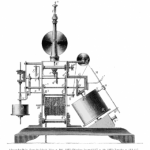Weekly Wrap Volume 86
 The Heroic Death of Chariots of Fire’s Eric Liddell
The Heroic Death of Chariots of Fire’s Eric Liddell
Imagine you dedicated your adult life to helping those less fortunate than yourself -that you spent your entire adult life trying to make the world a better place, and when you died (after sacrificing your own life for someone else’s) all most people remembered about you was that you once ran really fast… You’d be pretty annoyed right? Well that’s what happened to Eric Liddell. Although, as you’ll see, he probably wouldn’t have minded. Liddell is mostly famous for being one of the subjects of the film Chariots of Fire, along with running buddy, Harold Abrahams. If you’re unfamiliar with the film or just want to see us clumsily stumble our way through describing the plot, the film basically follows Liddell and Abrahams through… (more)
 Is It True That a T-Rex Couldn’t See You If You Didn’t Move?
Is It True That a T-Rex Couldn’t See You If You Didn’t Move?
In the immensely popular (despite the sins) movie Jurassic Park, there’s the famous scene where the giant T-Rex is attacking a jeep during a thunder storm. As it attacks, Dr. Alan Grant, a self-respecting paleontologist, yells, “Don’t move! He can’t see you, if you don’t move.” Here’s the thing – that’s wrong. (If that comes as a blow, you’re definitely not going to want to learn the shocking truth about Velociraptors.) The Tyrannous Rex not only could see just fine, whether the object was moving or non-moving (which helps one not run into things), there’s also quite a bit of evidence that the T-Rex’s sight was extremely good, very possibly better than modern-day hawks and eagles. This non-moving “fact” from the hit 1993 movie inspired a good deal of research into the subject. Professor Kent Stevens at the University of Oregon began the project DinoMorph in 1993. His goal was to develop “a means to create scientifically useful yet simplified… (more)
 The Phantom of the Forest, The Story of Barry Prudom
The Phantom of the Forest, The Story of Barry Prudom
For 17 days in the summer of 1982, Barry Prudom was the most wanted man in all of England. Barry’s uncanny ability to blend into the woods of North Yorkshire and evade capture, even when hundreds of polices officers were searching for him in a relatively small area, earned him the nickname “The Phantom of the Forest”. According to the British papers who dissected his life following his short, bloody stint as a fugitive, Barry Prudom had “an unremarkable youth” that was punctuated with bouts of criminal mischief that more often than not landed the youngster in trouble. Born in Leeds in 1944, Prudom was the result of an illicit and short-lived affair between a dressmaker and a soldier. Prudom’s father abandoned the pair shortly after his birth and was never heard from again by… (more)
 The Greatest Basketball Player You’ve Probably Never Heard Of
The Greatest Basketball Player You’ve Probably Never Heard Of
Ask a casual fan of basketball to tell you who the greatest player in history is and they’ll probably say that it’s either Michael Jordan or Bugs Bunny, depending on how many times they watched Space Jam as a kid. When basketball legend Kareem Abdul-Jabbar was asked who the greatest player he ever played against was, after a long an illustrious NBA career playing against many of the legends of the sport, he gave a surprising answer- “That would have to be ‘The Goat’”- a man who has variously been described by players and sports writers alike as the “the greatest basketball player to never play in the NBA”. Born in 1945 in a rural area of Charleston, South Carolina, “the Goat”, otherwise known as Earl Manigault, started out life in extreme poverty and hardship. The youngest of 9 children, Earl was taken in by a woman named Mary Manigault at around 7 years of age when it became… (more)
 A $25 Bonus– H. Tracy Hall and the Invention of the Synthetic Diamond
A $25 Bonus– H. Tracy Hall and the Invention of the Synthetic Diamond
As you may know, naturally created diamonds are formed from carbon subjected to extreme pressure (725,000 pounds per square inch or so) and heat (1,650 to 2,370 °F) some 90-120 miles down. The world’s natural diamond supply (that has come to the surface) was formed in this way some 1-3 billion years ago. However, scientists only realized that diamonds are the crystallized form of carbon in 1772 when Antoine Lavoisier made the discovery. Despite work by numerous scientists in the intervening years, the first synthetic diamonds weren’t created until 1954 by one Howard Tracy Hall. Born in 1919 in Ogden, Utah, Hall grew up in nearby Marriott. His family were members of the Mormon Church and lived on a farm far enough from town that heading there for supplies meant the whole… (more)
This Week’s YouTube Videos:
- How Many Burgers Come from One Cow? …and 8 other food facts.
- The Paperclip Controversy
- The Surprisingly Short History of the Pony Express
- The Queen of Baseball
- The Real Moby Dick
- The Surprising Cost of the Nike Logo
- Why Is It Illegal to Remove Your Mattress and Pillow Tags?
- Do Earwigs Really Lay Eggs in Your Ears?
- The Truth About Equestrian Statues
- When Did Humans Start Wearing Clothes?
- The Siberian Family Who Didnt See Other Humans For Over 40 Years
Bonus Quick Facts:
- Before the 19th century, all yeast leavened bread was a type of sourdough bread as they didn’t understand that it wasn’t the yeast itself giving the bread the sour taste. With advancements in microscopes though, they discovered this fact and were able to produce strains of yeast packaged and sold without lactobacillus.
- The word ‘desert’, as in “to get what is coming to you”, has been used in English since around the 13th century. This word, however, has fallen out of common usage and now, outside of the idiom “just desert”, is almost never used.
- In Roman mythology, Aurora was the goddess of the dawn, which is how the first part of the name “aurora borealis” came about. The “borealis” comes from the Greek name for the north wind, Boreas.
- Of the 39 ingredients that make up a Twinkie, only one of them is strictly a preservative or rather its only purpose in being included is because it’s a preservative. Some of the other chemicals have preserving side effects, but their use is primarily as substitutes for the dairy ingredients. The lack of these dairy ingredients and the air tight plastic wrap are the primary reasons that the Twinkie can last up to 25 days on the shelves and can out last so many of its other baked brethren in that respect.
- George Washington invented instant coffee… No, not that George Washington, but rather an English chemist, George Constant Washington.
- Johnny Carson once caused a near month long toilet paper shortage in the U.S. in December of 1973. In his show, he said, “You know what’s disappearing from the supermarket shelves? Toilet paper… There’s an acute shortage of toilet paper in the United States.” Americans promptly went out and bought up every piece of toilet paper they could find. Supermarkets tried to ration it, but to no avail. By noon the next day, pretty much all the nation’s supermarkets were sold out. After several days of toilet paper shortages due to this hysteria, Carson went on the air to try to explain it had been a joke and apologized. But because the shelves were almost always empty of toilet paper at this time, whenever some would come in, people would buy it all and hoard it. This toilet paper shortage lasted a full three weeks.
Other Interesting Stuff:
 A Brief History of the Ballpoint Pen and Whether NASA Really Spent Millions Developing a Pressurized Version Instead of Just Using Pencils
A Brief History of the Ballpoint Pen and Whether NASA Really Spent Millions Developing a Pressurized Version Instead of Just Using Pencils
The humble ballpoint pen is an item so ubiquitous the chances of you not having one near you right now are so low E.T could probably give you the percentage on his right hand. Few people realize just how much technology, craftsmanship and effort goes into creating a single pen- probably because you can buy 30 of them for a few dollars, only to mysteriously have them all disappear within a week. As the name would suggest, ballpoint pens work by utilizing tiny metal ball bearings. In the case of the most famous ballpoint pens of all, Bic, the ball is commonly made from tungsten carbide, which is notably the same material often used to make armour piercing bullets. After the material has been shaped, it’s then highly polished in a machine that uses a paste made from diamonds. Yes, we’re still talking about those pens… (more)
 Avoiding Being Sued With the “Small Penis” Rule
Avoiding Being Sued With the “Small Penis” Rule
The law is a funny thing and when it comes to defamation and libel, it’s notoriously murky. As such, writers often have to be careful when they’re trying to create characters “inspired” by real people to avoid a lawsuit. For writers who don’t care about that though, there’s always the small penis rule. In essence, the small penis rule is a way of avoiding a claim of libel by describing the libellous character as having a penis of comically underwhelming size. The idea being that few men would be willing to sue if it meant having to stand up in court and say that the character in the novel who’s seriously deficient in his nether regions is clearly based on them… (more)
 Why Do Other People’s Farts Smell Worse?
Why Do Other People’s Farts Smell Worse?
In 2005, two researchers published a series of articles investigating the subject of other people’s smelliness. They examined how much disgust people would feel and show after smelling a variety of odors, including armpits, garbage and farts. Among the stinks examined, farts elicited the strongest negative response, and across all body odors, people consistently rated odors of other people worse than their own (with one notable exception in that the armpit sweat of one’s partner was generally rated as less offensive than a person’s own. For why this might be the case, see: Why Do We Still Have Pubic and Armpit Hair) This all leaves us with the question of why other people’s farts smell worse. Probably the leading reason your own farts aren’t generally as offensive to your nose is that you’re used to your own smell. The more you’re used to something, like a smell, the more likely you are to, if not prefer it, at… (more)
 The Shockingly Old Origin of the Fax Machine
The Shockingly Old Origin of the Fax Machine
Today, we mostly think of the fax machine as an outdated piece of technology. While there are still some uses for it in an office-setting, technological advances are sending the fax machines to the same pasture as pagers, land-line telephones, and disposable cameras. Even if this is the last we hear of the beeps and bops that echo as an incoming fax is transmitted, the fax machine had a very long life – an amazing 171 years to be exact. Yes, the fax machine was invented in 1843, before the Model-T was even a dream, before the telephone was invented, and even before the American Civil War broke out. Alexander Bain, a Scotsman clockmaker living in London, was already a decently well-known inventor by the time he got to inventing the world’s first facsimile (meaning in Latin to “make alike”) – or fax – machine. In 1841, he had invented an electric clock by electrifying a pendulum (rather than using springs or weights), while submitting… (more)
 The Difference Between Green and Black Olives
The Difference Between Green and Black Olives
The primary difference between green and black olives is simply the point at which they are harvested. Green olives are picked before they are ripe, while black olives are allowed to ripen on the tree. The difference in color is primarily due to the olive’s ripeness when picked, but is also slightly affected by how they are processed. Green olives are soaked in a solution containing lye, then fermented in brine for anywhere between 6 to 12 months after being picked. The longer the olive is fermented, the less bitter and more flavorful it becomes. Green olives are usually pitted, and often stuffed with items such as pimientos, anchovies, jalapenos, garlic or onions. Black olives are also soaked in lye to lessen their bitterness, then cured in brine, but rarely stuffed. Other than that, there really isn’t much of any difference. On the minor side of things… (more)
 Racking Up Four Million Air Miles for Free- The Dollar Coin Scheme
Racking Up Four Million Air Miles for Free- The Dollar Coin Scheme
According to the U.S Treasury, a switch from paper bills to coins could theoretically save billions of dollars over the next few decades due to their inherently more hard-wearing nature. You see, although dollar coins cost slightly more to produce (18 cents a piece compared to the 4.9 cents it costs to produce a dollar bill), they can remain in circulation for nearly 30 years before wear and tear makes them unusable- far longer than the estimated lifespan of a dollar bill which is noted as being between 2-4 years. With this information in hand, experts have estimated that if a total switch was made, over a 30 year period, there would be a savings of about “13.8 billion dollars” in production costs. However, according to an extensive and thoroughly researched paper released by the Federal Reserve in 2013, switching from bills to coins would provide no real long-term savings to the economy because of the massive costs such a switch would incur… (more)
| Share the Knowledge! |
|





One comment